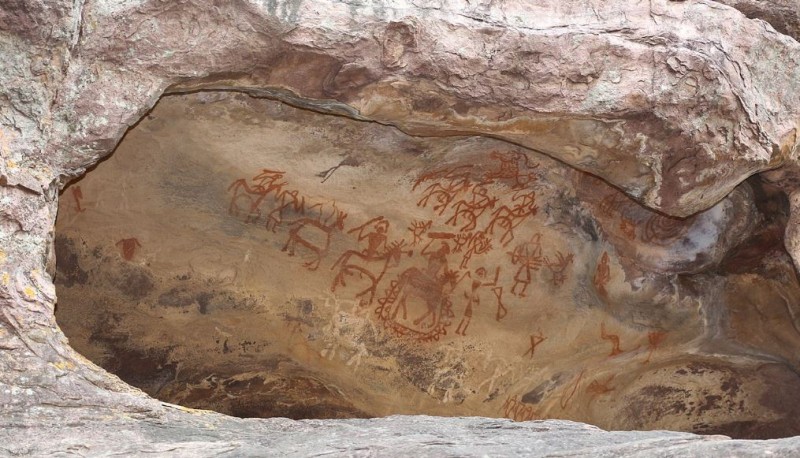
Bhimbetka stands as a testimony to the rich and ancient cultural heritage of the Indian subcontinent. Located in the state of Madhya Pradesh, Bhimbetka is an archaeological marvel, often referred to as India's oldest art gallery. The site is a living canvas, showcasing a breathtaking collection of prehistoric rock art dating back to thousands of years, making it one of the most significant archaeological discoveries in the country.
The story of Bhimbetka began in 1957 when a team of archaeologists stumbled upon this hidden gem. Led by Dr. Vishnu Wakankar, they were astounded by the discovery of the vast rock shelters adorned with vivid paintings and engravings. The name "Bhimbetka" is derived from the Sanskrit words "Bhimba" and "Ekka," meaning "Bhima's sitting place." According to local legends, Bhima, one of the Pandava brothers from the ancient Indian epic Mahabharata, took refuge in these caves during their exile, hence the name.
Also Read: India’s Best Art Galleries
In 2003, UNESCO recognized Bhimbetka as a World Heritage Site, cementing its significance as an invaluable cultural treasure.
Bhimbetka's rock art offers a glimpse into the lives and beliefs of early human societies, stretching back to the Paleolithic and Mesolithic periods. The art here is believed to span over 30,000 years, with evidence of human occupation from the Lower Paleolithic era to the early historic period. Such a long timeline suggests that generations upon generations of artists contributed to this living gallery.
Also Read: The World's Smallest Independent Nation: Vatican City
The rock sheltersat Bhimbetka number around 700, making it one of the most extensive collections of prehistoric art in the world. These shelters served as natural canvases, and early humans used a variety of techniques and pigments to express their creativity. The art can be classified into seven periods:
a. Paleolithic Period: The earliest artistic endeavors at Bhimbetka are attributed to the Paleolithic era, dating back around 30,000 years. The artwork from this period primarily consists of rudimentary depictions of animals, humans, and hunting scenes.
b. Mesolithic Period: The Mesolithic period, around 10,000 years ago, saw the emergence of more refined art forms. Artists began to experiment with colors, and the themes expanded to depict social and ritualistic activities.
c. Chalcolithic Period: During this phase, around 5,000 years ago, the art took a significant leap forward with the advent of the Chalcolithic cultures. Pottery designs and more intricate artwork reflecting the changing cultural landscape appeared.
d. Early Historic Period: The art from this period, dating back about 2,500 years, reveals interactions with early historic cultures. It showcases scenes from the Mahabharata and Ramayana epics, hinting at the transition to a more settled lifestyle.
Also Read: Top 5 Historical places to visit in London
Bhimbetka's art is not merely a collection of paintings; it carries deep symbolic and cultural significance. The themes predominantly revolve around daily life, hunting scenes, dance, music, and religious rituals. Animals such as bison, tigers, elephants, and rhinoceroses are depicted, reflecting the close association early humans had with wildlife.
The geometric patterns and symbols present in the artwork are thought to represent ancient communication systems, possibly denoting social structures, tribal affiliations, or territorial boundaries.
Bhimbetka's rock art is a fascinating time capsule providing insights into the lifestyle and cognitive abilities of our early ancestors. The presence of art in the prehistoric period suggests that these early humans possessed a complex cognitive and emotional world. The paintings also indicate their spiritual inclinations, as many figures have been interpreted as deities or symbols of worship.
Also Read: The Louvre Museum in Paris: From Royal Palace to Public Art Museum
Bhimbetka has become an essential destination for history enthusiasts, art lovers, archaeologists, and researchers alike. It offers a unique opportunity to witness the extraordinary artistic expressions of our early ancestors and serves as a reminder of the vast cultural diversity that India has harbored for millennia.
Bhimbetka stands as a living testament to the artistic capabilities and cultural richness of our ancient ancestors. The site not only serves as a repository of prehistoric art but also provides a profound connection to our shared human heritage. As we continue to learn more about Bhimbetka's secrets, we gain a deeper understanding of the journey that has shaped India and humanity as a whole.
Also Read: Exploring the Wonders of North America: Popular Places to Visit in the Continent